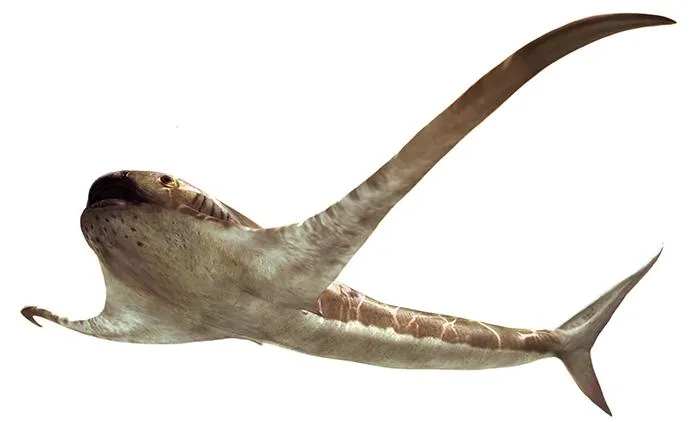Discovery of a 95-Million-Year-Old ‘Eagle Shark’ Fossil Makes Waves
The ancient creature likely used its six-foot-wide wingspan to move with ‘underwater flight’
/https://tf-cmsv2-smithsonianmag-media.s3.amazonaws.com/filer/48/d8/48d8c022-8cb2-4082-848f-6ed87998a94c/mar19_eagleshark.jpeg)
The eagle shark was probably not as fearsome as its name suggests. The ancient shark, described on March 19 in the journal Science, was most likely a slow-moving filter feeder that looked like a cross between a standard shark and a manta ray. But the eagle shark lived about 95 million years ago, 30 million years before modern rays appeared in the ocean. The find has paleontologists wondering of other ancient sharks took unusual shapes, since many are known only by the teeth they left behind.
The eagle shark, or Aquilolomna milarcae, fossil has the opposite appearance: an entire skeleton, but no teeth were preserved that would have helped paleontologists categorize it. The researchers took signs from other aspects of its anatomy—like its broad head and wide, wing-like fins—to draw conclusions about the shark’s behavior.
“As this shark probably fed on plankton, it didn’t need to go fast,” says Romain Vullo, first author of the new study and a paleontologist at the Université de Rennes, to New Scientist’s Adam Vaughan. “Like modern manta rays, relatively slow swimming was enough to eat plankton.”

A quarry worker found the unusual shark fossil in the Vallecillo limestone quarry in 2012. The region in northeastern Mexico is a well-known repository of marine fossils like ammonites, fish and marine reptiles, according to a statement. Local paleontologist Margarito González González learned of the discovery and set to work carefully chipping away at the stone to reveal the fossil that was preserved within, Riley Black reports for National Geographic.
“My first thoughts on seeing the fossil were that this unique morphology is totally new and unknown among sharks,” says Vullo to National Geographic.
While its head and side fins are unusual, the eagle shark’s tail and tail fins resemble those of modern sharks. So the researchers suggest that the shark probably used its tail to propel itself forward and its long side fins for stabilization. Manta rays have a different strategy, flapping their wide side fins to propel themselves forward.
"One of the most striking features of Aquilolamna is that it has very long, slender pectoral [side] fins," writes Vullo in an email to Laura Geggel at Live Science, "This makes the shark wider than long," because it is just over six feet wide but only about 5.4 feet long.
The fossil didn’t show signs of a dorsal fin—the notorious sign of an approaching shark that sticks up above the water—or of pelvic fins, which are on the underside of the shark. It’s not yet clear whether the eagle shark lacked these fins, or if they just didn’t fossilize, per Live Science.
The biggest mystery surrounding the eagle shark comes from the lack of teeth in the fossil. Paleontologists rely on sharks’ teeth to identify them and figure out their evolutionary relationship to other ancient sharks. The eagle shark might have had tiny, pointed teeth like the basking shark and the megamouth—two modern filter-feeding sharks—or taken a different strategy.
“It is truly unfortunate that no teeth were preserved in the specimen that could have allowed researchers to determine the exact taxonomic affinity of the new shark,” says DePaul University paleobiologist Kenshu Shimada to National Geographic.
For now, the research team used the shape of the fossil’s vertebrae and the skeleton of its tail fin to classify it as a shark in the order Lamniformes, which includes filter-feeding sharks, mako sharks and the great white. Future fossilized finds and analysis of the eagle shark’s anatomy could help scientists understand the strange shapes of sharks in the distant past.
“There are a lot of unusual features described by these authors, and I have some reservations about some of their interpretations,” says Humboldt State University paleontologist Allison Bronson, who wasn’t involved in the study, to National Geographic. “Ao I would be excited to see further investigations of this new, remarkable fossil.”